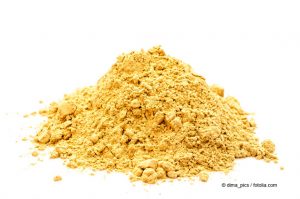Silicon dioxide is the main component of beach sand and is commonly known as quartz in its pure crystalline form. For industrial purposes the amorphous (non-crystalline form) silicon dioxide or silica is of greater importance. Amorphous silica can be found in a range of products including varnishes, glues and paints. It is also used in foods and in dietary supplements sold in drug stores and pharmacies.

healing clay © dima pics / Fotolia.com
How can I come into contact with this material?
Dietary uptake of small amounts of silicon is important for the human body as silicon is one of the ultra-trace elements. Amorphous silicon dioxide is also being used as a food additive (labelled E551) or as a component in medicinal clay whereby it could enter the human body via the gastro-intestinal tract. Dermal uptake of silicon dioxide particles derived from contact with paints, inks or adhesives is highly unlikely. Quartz, the crystalline form of silicon dioxide, can be inhaled as fine dust that is released from underground mining activities when digging for ore, coal and other minerals. Since the overall amount of silica in the environment is very high it is difficult to distinguish between naturally occurring silica and industrially generated silicon dioxide.
Is there any risk from this material to humans and the environment?
Nanoscaled silicon dioxide occurs almost exclusively in its unstructured amorphous form which so far hasn’t shown any negative characteristics in all performed experiments from animal to environmental studies. Silicon is an essential ultra-trace element for the human body and silicon dioxide in its amorphous form is considered to be non-hazardous. On the other hand the crystalline version of silicon dioxide is known to be harmful to humans: those who are permanently exposed to quartz dust, e.g. at their work place below ground, carry a high risk for chronic lung diseases (e.g. silicosis) and other pathological changes in the lung.
Conclusion
Humans come into contact with silicon dioxide particles on a daily basis: at the beach, in food products, like paints, glues and many more and this also includes silicon dioxide nanoparticles. The amorphous form of silicon dioxide is considered to be non-hazardous whereas the crystalline form has been shown to cause severe lung toxicity both in animals and humans.
By the way…
- Silicon dioxide is a constituent of many food supplements.
- Some plants and animals store silica internally in order to make themselves harder.
- Without silicon, there would be no computer chips or solar panels on the roof.
Properties and Applications
Silicon dioxide (SiO2) is the most common silicon compound and a major constituent of the Earth’s crust. Silicon dioxide is a very hard substance that is resistant against chemicals and alteration. Both crystalline and amorphous SiO2 are nearly insoluble in water and in acids. In aqueous suspensions, however, the very fine-grained forms of the amorphous type slowly transform into silicic acid SiO2 x n H2O. At 25 °C and a pH-value of 7 (neutral), approximately 0,12g SiO2 per liter water (120 ppm) dissolve that way . The dissolution rate of amorphous SiO2 is about 10 times higher than that of quartz. Particularly amorphous SiO2 can be dissolved by aqueous alkaline substances. Being resistant against other acids, SiO2 corrodes when exposed to hydrofluoric acid.
Natural silicon dioxide is an important base material for the glass industry, the optical industry and building industry. Quartz glasses provide the basis for manufacturing lenses and other optical components as well as temperature-resistant equipment for the chemical industry. Different kinds of SiO2 are used for manufacturing concrete and other building materials. In addition, SiO2 are used as filters and desiccants.
Synthetic amorphous SiO2 are used as fillers in plastics, rubber, dyes, and adhesives and serve as adsorbents or trickling agents. They improve the hardness and scratch resistance of surface coatings and varnishes. Although SiO2 has a lower hardness than aluminum oxide, which is used alternatively, clear varnishes that contain nanostructured SiO2 have a much better transparency.

Nanostructured silica serves as a filler alongside carbon black in new rolling resistance-minimized tires. © B.Mathes, Dechema.
Nano-SiO2 is used increasingly for tire manufacturing. Adding amorphous SiO2 as fillers in addition to Carbon Black, the tire roll resistance is reduced, and gasoline consumption decreases by up to five percent. Since CO2 emissions are reduced that way, this is not only easy on the wallet but also on the environment.
Amorphous silicon dioxides have been used for more than four decades as food additives (E551). They can be added to certain powdery foods such as table salt, seasonings, dietary supplements, and dry foods to avoid clogging. Moreover, they are permitted for use as carrier substances in emulsifying agents, colorings, and flavors. According to the EU Rules on Organic Farming, SiO2 additives are also approved for use in biological food. Since silicon dioxide can neither be absorbed nor salvaged by the human organism, it is excreted in its unchanged form. Amorphous SiO2 particles have been approved for use as food additives since they were first tested more than 40 years ago. Since the particle size and structure have remained unchanged, these substances are not considered products of modern nanotechnology .
Highly disperse (nanoscale) amorphous SiO2 are also contained in diverse pharmaceutical products such as tablets, suppositories, gels, and creams. The properties of the approved additives are laid down in the European Pharmacopoeia. Moreover, amorphous silicon dioxide nanoparticles are used as water repellents for cotton in the textile industry and as abrasives in the electronics industry .
Silicon dioxide is not self-inflammable as nanometer-sized powder. Also as a mixture with air (dust) under the influence of an ignition source, it is not inflammable, so there is no possibility of a dust explosion.
Occurrence and Production

Image of an Opal. © K. Luginsland, TECHNOSEUM Mannheim.
It occurs in nature in the crystalline (mostly quartz) and amorphous forms. Being a major constituent of sand, it is found in numerous types of rock and occurs, in addition, in precious stones and gemstones such as rock crystal.
The so-called amorphous non-crystalline silicon dioxides may be of biological origin or are formed by nature whenever rock is subjected to high temperatures (volcanoes, meteorite impacts, lightning strokes, geysers). Opals, which are very popular due to their ”opalescent“ colors, are an amorphous form of SiO2.
High quantities of amorphous SiO2 are produced at a large scale through precipitation or in oxyhydrogen flames. The latter product is often referred to as pyrogenic SiO2 or pyrogenic silicic acid. Pyrogenic SiO2 occurs as powder that consists of primary particles sized 5-50nm and forms solid aggregates above 100 nm (150-200nm). The powders are characterized by high specific surface areas (above 50m²/g).
Further Information
- European Council Regulation (EC) No 834/2007 (28.06.2007). Regulation (EU) 2018/848 of the European Parliament and of the Council of 30 May 2018 on organic production and labelling of organic products and repealing Council Regulation (EC) No 834/2007.
- European Directorate for the Quality of Medicines & HealthCare - European Pharmacopoeia (Ph. Eur.)
Humans are constantly in contact with amorphous silica, both in the nanoform and as larger particles, because it is included in many foods as a filler or anti-caking agent and is approved as a food additive (E551), which can be taken as an indication that it is not harmful. In contrast, crystalline silica (also known as quartz, microscale) is not used in foods because it is not approved. If inhaled, crystalline silica may cause cancer.
Everyday Contact
Classified as a non-toxic substance, amorphous silica is present (e.g. as a filler) in pharmaceutical as well as in cosmetic products. It is used in food processes (e.g. for beer clarification) and as a cleaning aid in toothpaste. In addition, amorphous silicon dioxide is found in paints and coatings, in scratch-resistant surfaces and many other applications. Since the particles clump together, the nanoscale plays a minor role.
Situation at the Workplace
In contrast to amorphous silica, inhalation of crystalline silica (quartz, microscale) causes silicosis, also called pneumoconiosis or ‘black lung’ disease. Silicosis refers to pathological changes in the lungs caused by the prolonged inhalation of quartz dust particles. This version of lung diseases is a recognized occupational disease requiring compensation. Therefore, appropriate protective equipment must be worn in the workplace when exposed to quartz dust, whether nanoscale or coarse-grained. In 2012, the International Agency for Research on Cancer (IARC) of the WHO published an assessment of the occupational exposure to crystalline silica (quartz) and the possible health effects . The difference between crystalline and amorphous silica also becomes clear when occupational exposure limits (OEL) are compared: for quartz, the maximum OEL in some European countries is 150 µg/m3 whereas mostly it is equal or below 100 µg/m3 for the inhalable dust fraction . Amorphous SiO2 on the other hand belongs to the inert dust fraction for which the OEL is between 3 and 10 mg/m3 for the inhalable dust .
Silicon dioxide is part of the engineered world. It is contained in a very large number of products and applications, both as microparticles or nanoparticles. Its good properties make it universally applicable. Amorphous silica is also well tolerated and is used in food, cosmetics, and medicines. Hence, humans are exposed to silicon dioxide on a daily basis.

Silicon dioxide naturally occurs as sand © dimakp/ fotolia.com
Silicon dioxide is a naturally occurring compound and crystalline silicon dioxide is the major constituent of sand. In case of environmental exposure, it is therefore difficult to distinguish between naturally occurring and technically produced nanoforms of silicon dioxide.
Due to the broad spectrum of applications and production volumes, an environmental exposure to silicon dioxide nanoparticle is very probable. However, to date, there only exist predicted environmental concentrations (PEC) of technically produced silicon dioxide nanoparticles (see cross cutting topic - Estimating the occurrence of nanomaterials in the environment).
Based on those theoretical models, industrially produced silica nanoparticles in Europe are most likely to be found in sediments, less in soils, air and water. The predicted concentrations are, however, far below those predicted to be harmful for environmental organisms .
The severity of the biological effects of silicon dioxide is strongly dependent on the structure of the material, i.e. whether it is crystalline or amorphous. The size of the particles, whether micro- or nanometer, plays only a minor role. Inhalation of crystalline silica causes considerable inflammation in the lung tissue; amorphous silica, on the other hand, triggers a brief inflammation in high doses, but after it subsides, no further effects occur.
Uptake via the Lung – Inhalation
Silica has either an amorphous or crystalline structure, which has a significant influence on its biological effects. Inhalation of crystalline silica causes silicosis, also called pneumoconiosis or ‘black lung’ disease. Silicosis refers to pathological changes in the lungs caused by prolonged inhalation of quartz dust particles. Inhalable quartz dust has been classified as carcinogenic by the International Agency for Research on Cancer (IARC) . The European Network on Silica (NEPSI) publishes a good practice guide for the safe handling of crystalline silica at the workplace.
In a comparative study, two groups of rats inhaled crystalline quartz particles or amorphous silica nanoparticles for three months. After this treatment Inflammatory reactions in the lungs were analysed. The crystalline form triggered significant inflammation that did not subside, whereas the amorphous silica induced a temporary inflammation only at high doses, which subsided after a short recovery time, and no further negative effects were observed . This behaviour of the two different structural forms of Silicon Dioxide is confirmed by further scientific work .
The amorphous silica was tested in two laboratory studies according to OECD guidelines. The rats inhaled the nanoparticles for short periods of time (5 and 28 days, respectively) at different doses and then they were examined for possible effects of SiO2 in the lungs. However, there were no negative effects observed in these experiments . During the same period, several experiments were also conducted with rats and similar nanoparticles, but with the method of instillation, which is very different from inhalation exposure, as it is less realistic and usually produces very high local concentrations in the lungs. In these studies, inflammatory reactions and oxidative stress were observed in the lungs of the experimental animals , but they occurred exclusively when the lungs were overloaded with particles, the so-called "overload effect". This effect always occurs when the cleaning processes of the lungs are overloaded .
The studies on lung exposure to silica demonstrate two things: on the one hand, this substance has hardly any effect in the amorphous form. On the other hand, however, overloading the lungs with dust particles must generally be avoided, since loading with high quantities or inhalation of high concentrations of particles over a prolonged period may well result in lung damage. However, this is not specific to silica, but applies to any form of dust particles that can be inhaled (see cross-sectional topic Granular Biopersistant Dusts). Under realistic conditions of everyday life, however, such a scenario hardly plays a role, since a situation cannot be found in which large quantities of dust are inhaled over weeks and months.
Uptake via the Skin – Dermal Uptake
Silicon dioxide is approved as a substance to be used in cosmetic products (e.g. skin care, toothpaste). Therefore, knowledge of possible absorption via the skin is an important factor in the safety assessment of this material.
Silicon dioxide in its amorphous form is found in many products, including skin care products or toothpaste. Since July 2013, substances deliberately added as nanoparticles in cosmetics must be labelled with the addition "(nano)" on the list of ingredients. The effects on the skin have been tested in numerous experiments, but only a few have investigated uptake into the body, as this is methodologically very difficult. Nevertheless, there are some very interesting results from recent studies. One study presented a direct comparison between a skin cell culture (HaCaT keratinocytes), a three-dimensional skin model ("EpiDerm®") and rabbit skin. It was shown that the isolated skin cells respond with a slight loss of viability only by treatment with very high concentrations of nanoparticles. However, the 3D model and rabbit skin did not show any loss of viability or skin irritation . Two years later, an extensive study was conducted to investigate different sized nanoparticles of amorphous silica and their penetration into human skin. Here it was observed, as studies with particles from other materials had already shown, that there was no penetration of the nanoparticles through healthy skin into the body (see also Body Barriers "Nanoparticles and the Skin").
Very remarkable is a British study with the 3D model "EpiDerm®". This 3D model, along with other models, meanwhile replaces animal testing, as animal testing for all cosmetic products has no longer been permitted in Europe since 2013. These three-dimensional skin models are composed and behave exactly like human skin. They consist of the different layers that also make up our skin: in the deep layers the living, proliferating epidermal cells and towards the surface with dead keratinocytes that cover our skin with 10-15 layers of dead cells, also called stratum corneum. A comparative study by Swansea University showed that simple cell cultures of skin cells responded to high concentrations of SiO2 nanoparticles with an increase in DNA damage, while the more realistic 3D model showed no symptoms or biological effects . In this study, penetration of the nanoparticles into deeper cell layers could also be ruled out, so that the silicon dioxide did not come into contact with the living cells of the epidermal layer. Another study was even able to demonstrate a protective effect of the SiO2 nanoparticles . In animal experiments with mice, two skin sensitizers were used to induce symptoms of allergy. However, when the skin of the animals was simultaneously treated with silica, the allergic symptoms did not occur. This was true for the negatively charged and neutral nanoparticles. Those that carried positive charges on their surface did not show this protective effect.
Taken together, the results of the experiments on the treatment of skin and skin cells with silicon dioxide prove that these nanoparticles have no harmful effect on the skin and cannot enter the body through healthy skin.
Uptake via the Gastro-Intestinal Tract – Ingestion
Amorphous silicon dioxide (SiO2) is considered non-toxic and is approved as a food additive (E551) and, because of its specific properties, is used in many food products as a filler or anti-caking agent. Due to the production conditions, this food additive may also contain a certain amount of nanoscale SiO2 particles. However, the majority of the produced SiO2 is needed for completely different applications, such as paints and varnishes, scratch-resistant surfaces, and many other everyday products.
In vitro studies with gastric or intestinal cells show that only very high concentrations of silica nanoparticles damage cells in culture . This is confirmed by another study in which different cell types from the gastrointestinal tract were treated with different concentrations of food-grade SiO2 nanoparticles. The cells did not show any toxic reactions at realistic concentrations, but only responded to very high doses of nano-silica with inhibited cell growth .
Another study also demonstrated a response of immune cells of the intestinal mucosa to relatively high concentrations of food-grade SiO2 nanoparticles. There was an uptake of the nanoparticles into the cells as well as an activation of intracellular signaling pathways . Furthermore, silica nanoparticles were able to stimulate the growth of intestinal cells in cell culture experiments . However, a true toxic effect was not observed here either.
Recent in vivo studies demonstrate that dietary SiO2 nanoparticles do not cause adverse effects in the gastrointestinal tract of rats. In these studies, 1.5 g/kg body weight per day was given for up to 90 days without any adverse effects on the test animals . Although none of the studies listed here were conducted with food-approved silica, even these mostly surface-active variants were not harmful to the gastrointestinal tract. In addition, silicon dioxide is mostly excreted undigested due to its poor solubility .
Silicon dioxide has no negative effect in the gastrointestinal tract either as micrometer or nanometer sized particles. In most cases, variants are tested that are not approved for use in food at all, and yet even these modifications of SiO2 are not toxic.
Uptake via medical application (iatrogenic)
Silicon dioxide is a pharmaceutical excipient and is used in pills, capsules, gels, ointments, and other applications. Cosmetics and personal care products also contain SiO2 to protect the skin or improve creams. Dietary supplements containing SiO2 are offered in pharmacies and drugstores to support hair and nail growth.
For silicon dioxide, an uptake in humans cannot be excluded because of the multitude of applications, also close to the body, or is even desired (food supplements, drugs). Since the beginning of the industrial use of silicon dioxide (since approx. 70 years), no negative effect has been observed for humans, neither for the microscale nor for the nanoscale particles.
Silicon dioxide occurs in two different crystal structures, amorphous and crystalline. The structure has to be considered, as it may influence the effect on environmental organisms. Most results are available for amorphous silicon dioxide nanoparticles. These nanoparticles were only harmful to environmental organisms in very high, non-environmentally relevant doses.

Towards bacteria and microbial soil communities, different sizes of silicon dioxide nanoparticles exert little toxicity. Due to the photocatalytic activity of some nanoforms of silicon dioxide, effects on bacteria are greater under illumination compared to exposure in the dark. Coarser silicon dioxide particles are considered completely non-toxic towards bacteria. Some studies even show a beneficial effect of silica nanoparticles on bacterial growth. Contrary, the bacteria in activated sludge are inhibited by silicon dioxide nanoparticles (see cross cutting topic - Nanomaterials in waste water treatment) .

Green algae are able to take up very small silica nanoparticles (5 nm), whereas larger particles are not able to cross the algae cell wall. Yet, particles are found to adhere to the surface of algae causing a reduction in algae growth, which can be traced back to shading effects. This effect, however, only occurs at very high and not environmentally relevant concentrations and can be reversed by natural organic matter, probably by preventing the particle attachment to algae .

Towards blood cells of mussels, silicon dioxide nanoparticles exert no acute toxicity but caused signs of inflammation as well as reactive oxygen production (ROS) .

Nematodes exposed to silicon dioxide nanoparticles show ROS formation, causing impaired mobility and reproduction .
 When tested for an application as a drug carrier, small amounts of silica nanoparticles injected into zebrafish embryos don't cause any negative effects. However, in other zebrafish studies, silica nanoparticles cause developmental and behavioural effects. In grass carp, nanosized silicon dioxide cause a change in the blood composition. Different fish cell lines representing different organs are more sensitive to silica nanoparticles if they originated from a tissue getting directly in contact with the environment, such as skin or gills .
When tested for an application as a drug carrier, small amounts of silica nanoparticles injected into zebrafish embryos don't cause any negative effects. However, in other zebrafish studies, silica nanoparticles cause developmental and behavioural effects. In grass carp, nanosized silicon dioxide cause a change in the blood composition. Different fish cell lines representing different organs are more sensitive to silica nanoparticles if they originated from a tissue getting directly in contact with the environment, such as skin or gills .

Upon exposure to silica nanoparticles, fruit flies show evidences for genetic damage. Silicon dioxide nanoparticles administered via the food cause slight intestinal cell damage to bumble bees and impaired their reproduction .
 Arabidopsis plants showed a slower growth and a reduced content of green leaf dye after exposure to silica nanoparticles via the roots. This is attributed to a reduced nutrient uptake due to the binding the nutrients to silicon dioxide nanoparticles. In other plants such as maize, rice, wheat, lupine, pumpkin and reed however, no toxic effects from nanoscale silicon dioxide are observed. Sometimes even the germination of seeds and the growth of seedlings is favoured .
Arabidopsis plants showed a slower growth and a reduced content of green leaf dye after exposure to silica nanoparticles via the roots. This is attributed to a reduced nutrient uptake due to the binding the nutrients to silicon dioxide nanoparticles. In other plants such as maize, rice, wheat, lupine, pumpkin and reed however, no toxic effects from nanoscale silicon dioxide are observed. Sometimes even the germination of seeds and the growth of seedlings is favoured .
The majority of the observed effects of silicon dioxide nanoparticles on environmental organisms were caused by very high and non-environmentally relevant concentrations. Therefore, according to current knowledge, environmental organisms are not endangered by silicon dioxide nanoparticles.
Only very high, unrealistic doses of silica nanoparticles cause inflammatory reactions and toxic effects in laboratory studies with rodents. Low doses of SiO2 nanoparticles do not induce toxicity in studies with experimental animals.
Distribution and Effects in the Body
Nanoparticles of silicon dioxide (SiO2) can be either amorphous or crystalline and both forms have different effects on cells . Consumer products contain the amorphous form. Synthesized particles are also mostly amorphous, whereas nanoscale crystalline SiO2 is formed by grinding coarse quartz. In general, according to current knowledge (year 2020), nanoparticles of amorphous silica tend to be considered harmless . Crystalline SiO2 nanoparticles, however, trigger significant effects, including DNA damage in cells .
To study the distribution of silica particles (nano- or microscale) in the body is not possible after "normal" exposure via the lungs (inhalation) , the gastrointestinal tract (ingestion) or via the skin, since the overall amount of material which enters the body via these uptake routes is too small to be detected. Therefore, all studies on the distribution of silica in the body are performed by injection. For this purpose, the total dose is injected either directly into the bloodstream (intravenously = i.v.) or into the abdominal cavity (intraperitoneally = i.p.).
Direct administration into the organism via injection into the bloodstream
A distribution of silica nanoparticles can only be reliably investigated if the entire dose is injected directly into the body. This was done in all studies cited in this section via injection into the blood vascular system (i.v.). Strict care must be taken that the amount of particles injected is not too large, as this can lead to the formation of blood clots (thrombosis) and thus directly to vascular occlusion with subsequent infarction and death of the animals. This observation was made when large amounts of silica were injected into rats to study the acute toxicity of SiO2. However, after repeated administration of smaller amounts of SiO2, no adverse effects such as DNA damage were observed. When acute toxicity is investigated, contradictory results are found in the literature. While in one study the LD50 for SiO2 nanoparticles was 262 mg/kg in mice , in a more recent study with up to 300 mg/kg not a single mouse died .
Distribution in the organism
A number of studies have addressed the question of whether silica nanoparticles reach internal organs in the organism after being injected into the body of animals. These internal organs include the heart, liver, kidney, spleen, lungs, or brain. For this purpose, mice or rats were injected with up to several hundred milligrams of SiO2 per kilogram of body weight, sometimes injected in repeated dose experiments . . The following key statements apply to the majority of the cited studies:
- The injected nanoparticles accumulate mainly within the liver, followed by the spleen, lungs, and kidney. Thus, the nanoparticles behave like any other foreign substance, which enters the body.
- Other organs such as the heart and brain are not affected, which also means that the blood-brain barrier is not crossed.
- If the silicon dioxide is administered in high doses (> 100 mg/kg) or in repeated dose experiments, inflammatory processes and a slight fibrosis can be observed in the liver. However, this subsides rapidly after the treatment has been stopped.
- No direct DNA damage was observed in animals even at high doses.
- Concentrations below 50 mg/kg do not induce any effect in the animals, neither in the major organs, such as liver and spleen, nor in the vessels or other cells.
Placental barrier and the foetus
One study addressed the distribution of silica nanoparticles in pregnant mice. In these experiments, it was observed that the particles (between 25 and 115 nm in size) could cross the placental barrier after injection into the pregnant females but did not cause clinical symptoms in either the female mice or the foetuses .
Inhalation uptake and dose dependence
In studies in which laboratory rats of different ages inhaled amorphous silica particles, it was shown that old rats responded more sensitively to identical treatment than young or adult animals. Effects on the lungs and heart could be observed .
In a comparative study, two groups of rats inhaled crystalline micrometer-sized quartz particles or amorphous silica nanoparticles for three months. The inflammatory reactions in the lungs of the rats and other effects (e.g. genotoxicity) were analyzed in this study. The crystalline form (quartz) triggered significant inflammation by this treatment, which did not subside by the end of the experiment. The amorphous nanoscale SiO2, on the other hand, triggered a short-lived inflammation at high doses, but this quickly subsided, and no further adverse effects occurred . These results are confirmed by further studies, which did not observe any statistically significant effects of (micro- or nanoscale) amorphous SiO2 in animal experiments ..
As in the in vitro studies, the dosage in vivo plays a decisive role. Treatment with very high doses leads to an overloading effect of the lung ("overload effect" ). Such high doses induce the development of fibrosis or trigger other damage such as inflammatory processes or oxidative stress .
For silica particles, there is a clear distinction between crystalline SiO2 (quartz), which can cause a known and well-studied lung disease, and amorphous SiO2, which is used in many products and has very little to no toxicity.
Uptake and Effects in Cells
Silicon dioxide has been the subject of toxicological studies in the laboratory for many decades. Depending on the cell type and crystal structure of the silicon dioxide, different reactions are triggered. Electron microscopy can be used to show the uptake and localization of silicon dioxide nanoparticles in cells.
Micrometer-sized crystalline silica particles (quartz) are known to enter the interior of cells. They are enclosed by membranes inside the cell and remain there .
As is true for many other nanomaterials, amorphous silica nanoparticles can be taken up by cells. They accumulate in cells in vesicles , which serve, among other things, to digest molecules in the cell. SiO2 nanoparticles are not found in the nucleus and do not cause structural changes in cells.
A large-scale comparison study with cell types of different target organs (e.g. respiratory tract, immune system, digestive tract) demonstrated that the effect of amorphous silica nanoparticles can also be cell-specific. While stem cells and some immune cells showed a reaction already at lower concentrations, the majority of the investigated cell cultures of the respiratory tract or other organs were very insensitive and reacted only at very high SiO2nanoparticle concentrations or not at all . These results are confirmed by other studies, all of which observed uptake of SiO2 nanoparticles, but the biological responses of treated cells occurred exclusively at high or very high concentrations .
In realistic concentration ranges, i.e. relevant for humans, silica nanoparticles do not cause significant effects and are not toxic .
Coculture systems often respond more sensitively to external influences because communication between the different cell types is possible, which is not the case in cultures with only one cell type. Thus, such coculture systems show stronger effects to SiO2 treatment when compared with the effects of studies with only one cell type .
The low or non-existent toxicity of silicon dioxide is also interesting for medical applications. Thus, attempts are being made to use porous SiO2 particles to introduce genes into the lungs of mice , or they are "loaded" with drugs and thus serve as a carrier to specifically combat diseases directly at the site of action .
The liver is the most important detoxification organ in mammals and all foreign substances accumulate and are processed there. This is also true for injected SiO2 nanoparticles and thus it is not surprising that they accumulate in the liver and lead to mild inflammation and fibrotic effects at high exposures. Internal tissue barriers are either not crossed at all (blood-brain barrier) or only in rare exceptions (placental barrier), as shown in experiments with pregnant mice. However, it must be taken into account that the placenta of mice have a completely different structure and are much more permeable than the placenta in humans.
Silicon dioxide nanoparticles are hardly absorbed into the body via the "normal" uptake routes (lungs and gastrointestinal tract) and not at all via the skin. Even if they are injected directly into the body, they have an effect only in very high concentrations, but usually also very low (inflammatory processes, DNA damage, etc.) and reversible. Thus, amorphous silica nanoparticles can be classified as non-toxic.
Silicon dioxide nanoparticles are stable in aqueous solutions compared to other particles which can affect their behaviour, e.g. in sewage treatment plants. In addition, silicon dioxide nanoparticles can bind other (harmful) chemicals already present in the environment.
Due to their negative surface charge under natural conditions, silicon dioxide nanoparticles are very stable in aqueous solutions compared to other particles. That is also why, in contrast to many other synthetic nanoparticles (e.g. titanium dioxide, fullerenes), silicon dioxide nanoparticles do not bind humic acids even though other constituents of the natural organic matter can absorb to the surface. It was also found that in sandy soils smaller silica particles are less mobile than larger ones .

wastewater treatment plant © Mariusz Szczygie / fotolia.com
In wastewater treatment plants, it is assumed for the purification of nanoparticle-containing effluents that a high salt content of the water will result in rapid agglomeration. This will lead to sedimentation of the particles and consequent removal of these particles from the water. However, this assumption does not apply to silicon dioxide nanoparticles due to their stability even in the presence of salt. Therefore, for this type of particle (and potentially other particle types), the wastewater cleaning procedure should include an additional filtration step (see cross cutting article – nanomaterials in the wastewater treatment plant) .
Silicon dioxide nanoparticles are able to bind aromatic hydrocarbons such as phenanthrene and naphthalene. The binding strength is dependent on the solutions’ pH. Silicon dioxide nanoparticles can also bind dichlorophen leading to an acceleration of degradation of this chemical. Accordingly, silicon dioxide nanoparticles may alter the availability of contaminants for environmental organisms .
Silicon dioxide nanoparticles have a low tendency for agglomeration and sedimentation in aqueous solutions. They can bind various chemicals. This may have an impact on the effects of these chemicals on animals and plants.
 >
>